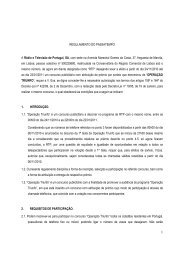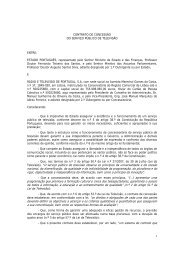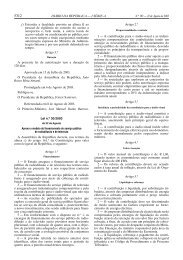The Soviet AGIs had near global patrolling areas. There was a concentratedeffort to monitor off <strong>the</strong> sou<strong>the</strong>astern coast of <strong>the</strong> U.S. (where U.S. surface andsubmarine units were concentrated), in <strong>the</strong> English Channel, <strong>the</strong> Norwegian Seaand off Holy Loch. In <strong>the</strong> Indian Ocean and Mediterranean Sea, Western navalmovements were monitored, particularly near <strong>the</strong> straits of Gibraltar, Hormuzand Bab El Mandeb, and <strong>the</strong> Suez Canal. In <strong>the</strong> Pacific Ocean, <strong>the</strong>re was correspondingemphasis off <strong>the</strong> coasts of China, Japan, Guam and in <strong>the</strong> watersaround Vietnam.The dependence of <strong>the</strong>se “spy ships” on provisioning from foreign ports wasdifficult to gauge, but must certainly have been considerable. As noted by one140 <strong>Bases</strong> <strong>during</strong> <strong>the</strong> <strong>Cold</strong> <strong>War</strong>İ 2007 Robert E. Harkavysource, <strong>the</strong> Soviet Union had chosen “not to build an auxiliary fleet of <strong>the</strong> sizenecessary to reduce out-of-area base support to a manageable minimum . . . Shipdesigns, both for ease of maintenance and for reasons of habitability, still arenotoriously poor . . . Unlike U.S. ships, most Soviet ships cannot distill enoughfresh water and are dependent upon water tankers.”This situation necessitated frequent operational port visits by auxiliaries totake on food and fresh water, which were <strong>the</strong>n transferred to combatants, presumablyalso AGIs, at roadsteads or at sea. This presumably fur<strong>the</strong>r directedattention to <strong>the</strong> main Soviet basing hosts and clients – Cuba, Angola, Syria,Vietnam, South Yemen etc. – as critical to fueling and o<strong>the</strong>rwise provisioning<strong>the</strong> Soviet Union’s global AGI effort.Soviet forward-based missiles79By <strong>the</strong> mid-1980s, of course, both <strong>the</strong> U.S./NATO and <strong>the</strong> USSR deployed largenumbers of externally based, nuclear-armed missiles in Europe, constituting amassive and critical forward presence. Centrally, this involved Soviet deploymentof short-range <strong>the</strong>ater weapons and tactical weapons in Eastern Europe(SS-12/22s, SS-23s and SS-7 “Frogs”) and a countervailing U.S. deployment ofPershings, cruise missiles and Lance battlefield weapons.The Soviet SS-20 <strong>the</strong>ater missiles which were at <strong>the</strong> center of <strong>the</strong> INF negotiationswere first deployed in 1977. These missiles, carrying three nuclear warheadswith ranges of 3400 miles (5000km), were phased in to replace <strong>the</strong> olderSS-4s. The latter were first deployed in 1959, with a single warhead platformand a range of 1120 miles.By 1987, it was typically reported that over 300 SS-20s were deployedagainst NATO west of <strong>the</strong> Ural Mountains, with ano<strong>the</strong>r 100 or so in SovietAsia, for a total of 441. None of <strong>the</strong>se were based outside <strong>the</strong> USSR (nor wereany of <strong>the</strong> 112 reported SS-4s which were still deployed in <strong>the</strong> western USSR).They were based in several fields in <strong>the</strong> western Soviet Union and near <strong>the</strong>Caspian Sea. The SS-20s threatened <strong>the</strong> entirety of NATO-Europe with <strong>the</strong>ir5000-km ranges, as well as many o<strong>the</strong>r important targets – <strong>the</strong> Azores, Greenland,Philippines, Guam, Okinawa, etc.O<strong>the</strong>r nations’ external basing: Britain and France80Somewhat in <strong>the</strong> face of historical nostrums associated with Mahan and o<strong>the</strong>rs,it is apparent that <strong>the</strong> <strong>Cold</strong> <strong>War</strong> competition – if that is what it was – for overseasnaval access was largely a two-nation game. In that sense at least, bipolarityunquestionably reigned. There were, none<strong>the</strong>less, a few not altoge<strong>the</strong>r insignificantinstances of naval basing retained by – or recently acquired by – some o<strong>the</strong>rnations: France, Britain, Australia, <strong>the</strong> Ne<strong>the</strong>rlands and maybe o<strong>the</strong>rs. Of course,almost all navies conduct periodic port visits abroad, variously involving “presence,”solidification of political friendships, broadening of horizons for navalpersonnel, and so on.<strong>Bases</strong> <strong>during</strong> <strong>the</strong> <strong>Cold</strong> <strong>War</strong> 141İ 2007 Robert E. HarkavyFrance had <strong>the</strong> most significant external naval presence besides <strong>the</strong> superpowers,most notably represented by its Indian Ocean Flotilla (Alindien) of fivefrigates, three minor combatants, two amphibious and four support ships (also asmall naval marine detachment). That force was deployed out of Djibouti (hencewas within combat range of <strong>the</strong> Persian Gulf), also making extensive use ofbases at Reunion and Mayotte (Mozambique Channel), both French overseaspossessions (earlier, up to 1973, France had extensive access to Diego Suarez inPage 48Page 49
Madagascar). There was also a significant naval presence in <strong>the</strong> Pacific: fivefrigates, five minor combatants, seven amphibious and 12 support ships. Thatforce operated out of Noumea, New Caledonia and also patrolled via Tahiti(Papeete), Muroroa and o<strong>the</strong>r French dependencies in <strong>the</strong> southwest Pacific.Two small ships were also normally rotated about between <strong>the</strong> Antilles (PortLewis, Guadeloupe) and Guyana. The French Navy also made extensive use of anumber of o<strong>the</strong>r ports, mostly in closely aligned African nations: most notablyDakar (Senegal), Abidjan (Ivory Coast) and Libreville (Gabon). During <strong>the</strong>events of 1987, France’s access to Djibouti allowed for a significant naval presencein <strong>the</strong> Gulf of Oman, outside <strong>the</strong> Straits of Hormuz. That presence wasreported as consisting of three minesweepers, three escorts, one anti-submarineship, <strong>the</strong> aircraft carrier Clemenceau and two frigates.Great Britain’s once near astonishing network of overseas naval bases andaccess had by 1985 dwindled to a very small remnant, aside from still extensiveroutine port calls by <strong>the</strong> Royal Navy. Small naval forces were still permanentlydeployed in Belize, Gibraltar and Hong Kong. A relatively large force, includingan ASW carrier, an SSN and several escorts and auxiliaries remained in <strong>the</strong>Falklands in <strong>the</strong> wake of that (not wholly resolved) dispute. A small navaldetachment (one or two destroyers or frigates and a couple of support ships)moved about <strong>the</strong> Indian Ocean, making use of Diego Garcia, Singapore, Perthand so on, and had quietly been used to escort ships in <strong>the</strong> Persian Gulf. Thatpresence, which apparently utilized access to Bahrain, was reported in 1987 toconsist of two warships, one fleet tanker, four minesweepers and a supply ship.O<strong>the</strong>rwise, within NATO, only <strong>the</strong> Ne<strong>the</strong>rlands permanently deployed a tinynaval presence outside Europe – <strong>the</strong> Dutch retained a small presence at Curacaoin <strong>the</strong> Caribbean. (Spain was reported to have established a small “fishing” presencein Equatorial Guinea after <strong>the</strong> expansion of <strong>the</strong> Soviet Navy from Luba.)As in so many o<strong>the</strong>r ways, <strong>the</strong> matter of external basing of aircraft remained<strong>during</strong> <strong>the</strong> <strong>Cold</strong> <strong>War</strong> primarily a two-nation game, reflective of <strong>the</strong> tenacioushold of bipolarity which had characterized global basing networks in <strong>the</strong> postcolonialera. Earlier, of course, <strong>the</strong> primary colonial powers – Britain, France,Italy, <strong>the</strong> Ne<strong>the</strong>rlands, Portugal, Spain – all had had extensive networks of airbases closely associated with colonial garrisons and with colonial rivalriesamong <strong>the</strong> European powers <strong>the</strong>mselves. In <strong>the</strong> 15–20 years after 1945, <strong>the</strong>seassets gradually dwindled, and in <strong>the</strong> process <strong>the</strong> number of bases available to<strong>the</strong> U.S. and, more generally, to <strong>the</strong> Atlantic alliance contracted. But <strong>the</strong>re werestill some remnants, and in <strong>the</strong> case of France at least, even <strong>the</strong> hint of a slightexpansion of an overseas air power presence.142 <strong>Bases</strong> <strong>during</strong> <strong>the</strong> <strong>Cold</strong> <strong>War</strong>İ 2007 Robert E. HarkavyOf course, <strong>the</strong>re was some intra-NATO alliance forward basing of aircraft inWest Germany; again, associated for obvious reasons with land-force deploymentsand, indeed, located immediately to <strong>the</strong> rear, westward of those forces.The British Army of <strong>the</strong> Rhine was backed up by significant forward Royal AirForce (RAF) deployments, involving 12 aircraft and two helicopter squadrons,six deploying nuclear-capable Tornado strike aircraft (co-developed in a consortiumwith <strong>the</strong> FRG and Italy), one of Jaguar reconnaissance aircraft and two ofPhantom fighters; also among <strong>the</strong>se were two squadrons of Harrier jump jets(nuclear-capable) and one of Pembroke communications aircraft. These aircraftwere stationed at several main air bases in nor<strong>the</strong>rn Germany: Laarbruch,Bruggen, Wildenrath and Gutersloh. Canada’s contribution, fur<strong>the</strong>r south inBaden Wurtemberg, consisted of forward deployment of three squadrons of 36CF-18s at a base at Baden Sollingen, supported by liaison aircraft and 2700 personnel.In addition, <strong>the</strong> West German Luftwaffe had training and some supportfacilities in Portugal, <strong>the</strong> U.S., <strong>the</strong> U.K. and Canada, and had permanently based18 Alpha jets at Beja in Portugal, mostly in connection with training activities.Elsewhere, overseas, some remnants of what obviously once was a muchlarger RAF presence remained. There were some aircraft or helicopters permanentlystationed at <strong>the</strong> Falkland Islands, Ascension, Belize, Brunei, Cyprus,Gibraltar and Hong Kong. Of <strong>the</strong>se, <strong>the</strong> RAF maintained only helicopters and/orutility aircraft in Brunei, Cyprus (Akrotiri) and Hong Kong, though Phantomsand Lightning fighters were sometimes deployed to Cyprus. There were apparentlyVictor bomber and Hercules C-18 tanker detachments on Ascension, in <strong>the</strong>late 1980s, no doubt to provide <strong>the</strong> wherewithal for ano<strong>the</strong>r logistics operationto <strong>the</strong> Falklands, if that should have been necessary. There was a helicopterPage 50
- Page 2 and 3: This provided the U.S. access to a
- Page 4 and 5: ecame a hot issue within Japan, and
- Page 6 and 7: SpainRotaMajor naval base; also air
- Page 8 and 9: eturn to the link here with aircraf
- Page 10 and 11: which were in Fairbanks (Alaska), T
- Page 13: Molesworth), Belgium (Florennes), t
- Page 17 and 18: III,” 14 stations giving flexible
- Page 19 and 20: wire retaliation strike plan. The n
- Page 21 and 22: Ocean surface surveillance47The U.S
- Page 23 and 24: each site, providing variable cover
- Page 25 and 26: Pinetree LineCanadaBroughton Island
- Page 27 and 28: that is, the Limited Test Ban Treat
- Page 29 and 30: Missile Crisis.68At another level,
- Page 31 and 32: Access for Soviet surface ships.Per
- Page 33 and 34: nel in Libya, whose air force compr
- Page 35: systems (an exception, of course wa
- Page 39 and 40: Aden, Bahrain, Malta, Mauritius, Si
















